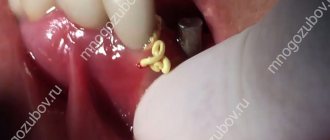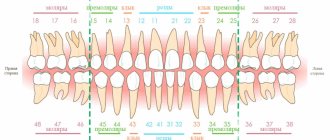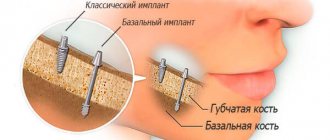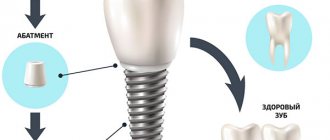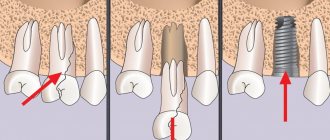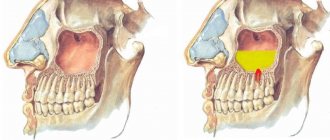Implantation is the replacement of a lost tooth with an artificial one. For an implant to function like a natural tooth, it must be securely secured. Unfortunately, as soon as we lose a tooth, the bone tissue begins to decrease. Over time, the atrophy becomes so pronounced that there is simply nowhere to insert the metal pin; there is not enough space for it.
In the upper jaw, bone loss is accompanied by a descent of the maxillary sinus membrane. As a result, there is not enough bone volume, and there is also a risk of membrane perforation during surgery.
Dentists have developed a bone grafting method that lifts the wall of the maxillary sinus. They called it sinus lifting, from the words “sinus” (maxillary sinus) and “lift.”
How it's going
Sinus lifting and implant installation are possible with open and closed methods. Whatever method the doctor chooses, it all starts with preparation. The implantologist assesses your general health and treats your gums if necessary. Blood tests make it possible to rule out infections and inflammatory processes. It is important to tell your doctor about allergic reactions.
A panoramic image (orthopantomogram) and CT will help assess the condition of the jaw, indications for implantation and augmentation. Installation of implants immediately after sinus lift is possible if the bone thickness is 5 mm or more. A CT scan will also show the presence of inflammatory processes in the maxillary sinus, cysts or tumors for which surgery cannot be performed.
On the second day and further after surgery
How and what to eat? On the second day and for about a week, it is important to follow a diet. To a greater extent, it concerns the condition and temperature of food. Food should not be hard, hot or cold. You should also not over-salt the dish or generously flavor it with spices - this can cause irritation of the mucous membranes. You need to chew food on the side where the intervention was not performed. And, of course, during this period special attention should be paid to a balanced diet - the body needs a maximum of useful vitamins to restore itself.
Vitamin C is important for gums and immunity, calcium, phosphorus and fluorine, and vitamin D are important for bone tissue restoration. So in the first days, your diet should consist of pureed meat, fish, dairy products, eggs, and various soups. You can eat both boiled or baked and fresh vegetables and fruits. At first, make salads - use a grater for this, and towards the end of the week you can cut them into small pieces and carefully chew on the side where surgery was not performed.
How do you know that the wounds have healed? Firstly, you will visit your doctor regularly - he will monitor your condition. Secondly, an indicator that rehabilitation has come to an end is the absence of swelling and pain upon contact with the wound, as well as the pink color of the gums.
What can you drink? Drink as much regular water as possible - it will allow the body to recover. As on the first day, it is advisable to avoid coffee and tea, which can cause pressure surges. Hot and very cold drinks are again prohibited.
Is it possible to play sports? Physical activity should be limited for about a week. Excessive tension can increase the inflammatory process and lead to suture divergence. This means that you should stop all sports training and even such mundane activities as brisk walking or climbing stairs. Lifting weights should also be done with caution - keep your back straight, this will reduce pressure in the head area.
How to carry out hygiene? Starting from the second day after surgery, you need to start caring for your teeth and the entire oral cavity in order to get rid of bacteria that actively multiply and can cause tissue inflammation.
If you have been building up a large area, then it is better to wait a little while using the brush. During the first week, continue to perform soda baths, again without rinsing. If the area of extension is limited to one tooth, starting from day 2 you can use a soft brush with paste, avoiding the surgical area. Do not use dental floss or irrigator.
Is it possible to smoke and drink alcohol? As on the first day, there remains a ban on smoking and alcohol.
What medications should I take? As prescribed by your doctor. If on the second day there is no pain or it is tolerable, you can refuse painkillers - evaluate your well-being yourself.
Implantation with closed sinus lift
The skill of the doctor plays a decisive role in the success of any operation, but with a closed protocol, it is doubly important. The doctor approaches the membrane blindly; a lot depends on experience and intuition.
A bed for the implant is formed in the bone. Through it, the membrane is lifted with a special tool. The resulting cavity is filled with bone material and compacted. Then the pin is screwed in. The screw threads of these pins further compact the bone material as they move, increasing primary stability.
1 - formation of the hole, 2 - raising the bottom of the sinus, 3 - filling with bone material, 4 - installation of the implant
Open sinus lift with immediate implantation
This protocol seems more complex, but in fact the implantologist sees the surgical field, the risk of perforation is low.
The doctor creates a surgical window in the bone, lifts the shell, installs a protective membrane, and fills the hole with bone material. Then the implant is installed and the wound is sutured.
1 - formation of a hole in the bone, 2 - raising the bottom of the sinus, 3 - filling with bone material, 4 - installation of an implant
Rehabilitation
Recovery takes about a week
.
The duration of the rehabilitation period depends on the individual characteristics of the body and the type of operation. With an open protocol, swelling is greater and lasts longer. When closed, everything returns to normal in 3-4 days
.
On these days it is necessary:
- strictly follow the instructions;
- take antibiotics, analgesics;
- rinse your mouth with antiseptics;
- avoid hot, cold;
- eat soft, crushed food;
- limit physical activity;
- avoid temperature changes.
What is considered normal and what is pathology?
Any surgical intervention is associated with tissue damage, so there are normal consequences after surgery that do not require seeing a doctor. They go away on their own after some time, the only help from the patient is cold compresses, rinsing, taking painkillers, proper rest and protecting the wound from injury.
Complications are extremely rare - bone augmentation is considered one of the safest surgical operations in dentistry. However, they require prompt intervention by the attending physician.
Each patient of the Smile-at-Once clinic is assigned an individual manager who is on call 7 days a week and 24 hours a day.
Thus, all our patients are under reliable protection. If you have any doubts about whether the recovery period is proceeding normally, you can seek advice. Normal and complications after bone augmentation
| Norm | Complication | ||
| description | duration | description | when does it occur |
| Swelling of the mucous membranes and parts of the face | 2-3 days | Swelling, redness of the mucous membrane | on the 4th day and beyond |
| Increase in body temperature to 38-39 degrees | up to 3 days | High fever after she has already slept | on the 4th day and beyond |
| Soreness | up to 3 days, gradually decreases | Seam divergence | immediately and further |
| Discharge from the sutures or the area where the implant is installed. | up to 3 days, gradually decreases | Strong discharge, especially if accompanied by odor and inflammation | immediately and further |
| Minor bleeding immediately after surgery | up to 72 hours | Bleeding from the wound (profuse) | after 3 hours and beyond |
| Facial hematoma (bruise) | week, symptoms decrease | Loss of extension material or implant | immediately and further |
| Partial numbness of part of the face | up to 7 days | Numbness of the face | lasts for more than a week |
| Increased salivation | up to 72 hours until the denture is installed | Increased salivation | lasts for more than a week |
| Runny nose (clear fluid coming from the nose) | up to 2 weeks | Profuse runny nose, purulent discharge from the nasal cavity | immediately and further |
Possible complications
Complications are possible with any surgical intervention; installation of implants after sinus lift is no exception. The most common problem is perforation of the maxillary sinus membrane. A small perforation is not so dangerous, there is no reason to refuse the operation, but if the diameter is large, the procedure will have to be stopped. Also happens:
- Sinusitis
. Inflammation of the sinuses with accumulation of pus. - Fistula formation
. When an infection enters a surgical wound, it “eats” the bottom of the maxillary sinus. A passage into the oral cavity is formed. - Bleeding
. As a result of vascular damage, severe blood loss can occur. - Implant rejection
. The survival rate of implants from well-known manufacturers is 99%. Unfortunately, there are cases when the artificial root is rejected by the body. Therefore, it is important to tell your doctor about all diseases, allergies, and body characteristics in order to exclude the possibility of rejection.
A good clinic has equipment and tools to eliminate the consequences, but the main thing is prevention. In this case, the implantologist is highly qualified. The more experienced the doctor, the less likely he is to make a mistake.
Standards for performing surgery in our Center
For the success of the operation, it is important not only to strictly follow the surgical protocol, but also to take into account the smallest details.
Preparatory stage
Sinus lifting is preceded by careful preparation, the quality of which determines the positive outcome of the operation. Our specialists pay maximum attention to this stage. The list of preparatory procedures includes:
- Collecting the patient's medical history to exclude possible contraindications.
- Identifying bad habits. Tobacco smoke increases the risk of graft failure, so smokers should give up cigarettes for 2-3 weeks.
- Sanitation of the oral cavity, elimination of problematic issues (treatment, tooth extraction, relief of inflammatory processes).
- Examination of the nasal cavity to identify chronic diseases. If present, therapy is prescribed to prevent complications.
Read more about preoperative preparation - Preoperative examination and planning
Computer examination and modeling
Allows you to determine the size and structure of the bone, the condition of adjacent teeth, select the model and location of the implant, and eliminate risks.
- Targeted X-ray. Necessary to determine the condition of the roots of neighboring teeth, eliminating the risks of installing implants in an area bordering on inflammatory processes.
- CT scan of the upper jaw. Our Center has a safe 3D tomograph SIRONA GALILEOS (Germany) with precise ENT mode settings. Allows you to obtain information about the parameters and sizes of the bone, the location of the bottom of the sinus, and hidden diseases.
- Computer simulation of the future Nobel Guide operation. A three-dimensional model is created based on CT results. It is used to create a calculation of the optimal place for implantation, creating a 3D template for precise fixation at the calculated point of the jaw.
Choice of pain medications
- Local anesthesia involves the injection of local drugs into the operated area. The analgesic effect lasts for 2-3 hours. This is enough to relieve sensitivity to pain, but anxious patients may experience psychological discomfort.
- Sedation Surgery in a state of drug-induced sleep. A complex of light ultra-short-acting hypnotics provides psychological peace of mind to the patient. Completely eliminates discomfort, pain and, most importantly, the feeling of fear.
For sedation, we use safe, gentle, non-narcotic medications
Original imported drugs are safe and are eliminated from the body naturally within an hour. This type of anesthesia should not be confused with general anesthesia, which involves a state of deep sleep and a severe “exit” with clouding of consciousness. After sedation, you can go home within 40 minutes; hospitalization is not required.
Levin Dmitry Valerievich
Founder and Chief Doctor of the Center
Innovative technologies
- Ultrasound Piezosurgery To access the maxillary sinus, we do not use outdated protocols using a hammer, chisel and drills. The NSK VarioSurg device acts only on bone tissue and turns off when approaching the sinus mucosa, which prevents the risk of perforation.
- Lift-Control Micro Instruments The membrane is lifted delicately and very gently using a coordinated set of osteotomes and Meisinger instruments without damage or tearing.
Bone materials
To carry out a one-stage sinus lift, the following can be used:
- Autologous bone The patient's own bone taken from the lower jaw or chin. This option involves additional surgical intervention to collect the graft, so we do not use it.
- Allogeneic materials Bone tissue from another person is used. It is difficult to trace the origin and the degree of purification from the genetic component, so we also do not use it .
- Synthetic substitutes have not proven their effectiveness and are not able to form a strong foundation for reliable fixation of implants. They are not used in our Center .
- Biocompatible materials tricalcium phosphate We use bone preparations that are compatible with the tissues of the human body. They sprout with their own blood vessels and form new bone that can hold the implant and withstand the loads of chewing.
- Bone growth stimulators We use protein and collagen bone morphogenetic proteins (BMPs) from KEYSTONE. Stimulates the formation of new bone tissue. Combined with a PRP membrane obtained from blood plasma rich in platelets and growth factors.
Branded rehabilitation
Each patient receives a black bag with the necessary medications and recommendations. You won’t have to run to pharmacies looking for medications after surgery.
Tissue restoration after surgery lasts up to 7 days. Pain and swelling are possible, which decrease every day.
For those who want to recover faster, a complex of accelerated rehabilitation in 1-2 days has been developed:
- Bioreparation - injections of biostimulants to improve the condition of the skin, improve regeneration, relieve inflammation and swelling
- PRP plasma lifting - blood plasma accelerates metabolic processes, stimulates healing, eliminates hematomas and swelling
- Microcurrent therapy - weak currents improve blood circulation, improve cell restoration, relieve spasms and pain
